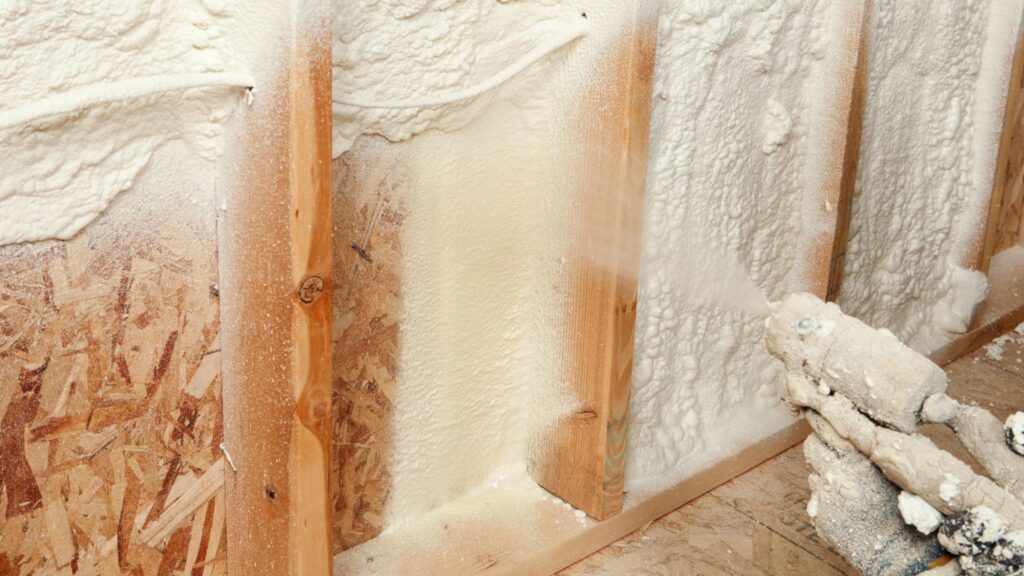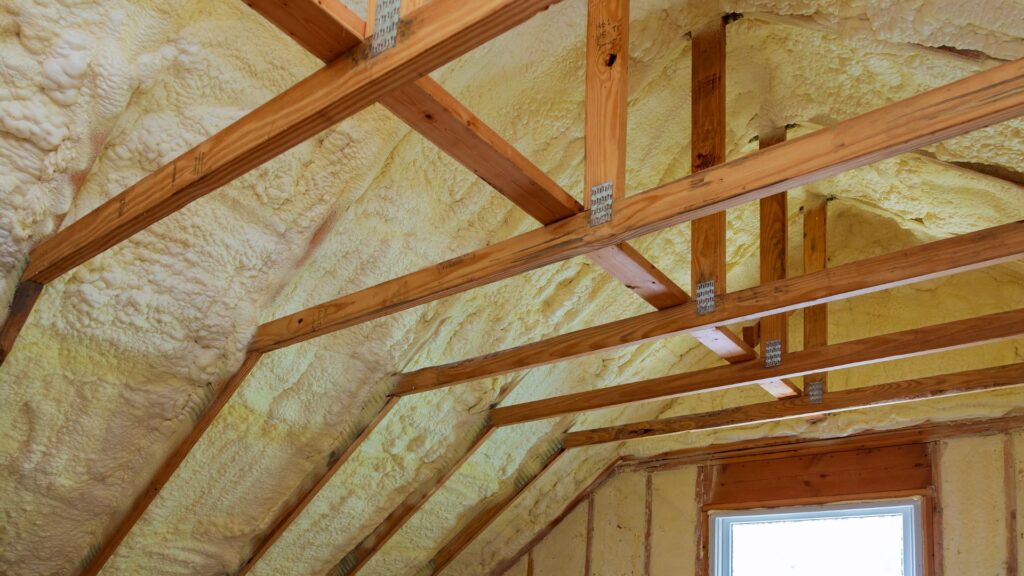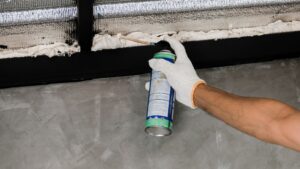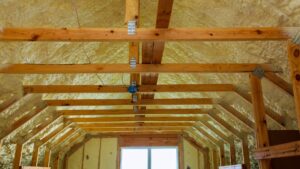Insulation plays a crucial role in maintaining a comfortable and energy-efficient home environment. It helps regulate indoor temperatures, keeping us warm during winter and cool in the scorching summer months. When it comes to insulation, Closed-Cell Spray Foam Insulation in Conroe stands out as an excellent choice to provide efficiency and durability. In this article, we will delve into the details of this insulation type and why it’s gaining popularity among homeowners.
Understanding Closed-Cell Spray Foam Insulation
Closed-cell spray foam insulation is a highly effective and versatile insulation material used in residential and commercial construction. It is composed of two main components, polyurethane and isocyanate, which are mixed on-site and sprayed into walls, ceilings, floors, and other building cavities. When applied, it expands and hardens, creating a dense, closed-cell structure that provides exceptional thermal insulation, air sealing, and moisture resistance. Here’s a more in-depth understanding of closed-cell spray foam insulation:
- Insulation and Thermal Properties: Closed-cell spray foam insulation, with high thermal resistance and a high R-value, effectively prevents heat transfer, maintains indoor temperature, and acts as a vapor barrier, reducing moisture infiltration and mold and rot issues.
- Air Sealing: Closed-cell spray foam acts as an air barrier, sealing cracks and gaps, improving energy efficiency, reducing heating and cooling workload, and enhancing indoor air quality by blocking pollutants and allergens.
- Structural Strength: Closed-cell spray foam insulation enhances building structural strength, making walls and roofs more resistant to wind, seismic forces, and other stresses, making it beneficial for hurricane-prone areas and retrofitting older buildings.
However, it’s important to note that closed-cell spray foam insulation typically comes at a higher cost compared to other insulation options. Additionally, its installation should be done by trained professionals, as the mixing and application process require careful handling of chemicals and equipment. Nevertheless, its superior insulating properties, air sealing capabilities, and structural benefits make it a popular choice for those looking to optimize energy efficiency and comfort in their homes or commercial buildings.

Efficiency Advantages of Closed-Cell Spray Foam Insulation
Closed-cell spray foam insulation offers several efficiency advantages when compared to other insulation materials. Here are five key efficiency advantages of closed-cell spray foam insulation:
- High R-value and Thermal Resistance: Closed-cell spray foam insulation boasts a high R-value, which is a measure of its thermal resistance. This means it provides exceptional insulation by preventing heat from escaping during winter and entering during summer, resulting in a more comfortable indoor environment.
- Moisture Resistance and Prevention of Mold Growth: Closed-cell insulation is impermeable to moisture. Its closed-cell structure prevents water infiltration, reducing the risk of mold and mildew growth within your walls. This moisture resistance ensures a healthier indoor environment and prolongs the lifespan of your insulation.
- Structural Enhancement: Closed-cell spray foam provides structural rigidity and strength to the building. When applied to walls and roofs, it can help improve the overall structural integrity of the building, making it more resistant to wind and seismic forces. This added strength can reduce the need for additional structural materials.
- Durability and Longevity: Closed-cell spray foam insulation is known for its durability and long-lasting properties. Once installed, it can remain effective for several decades without significant deterioration. This longevity means you won’t have to worry about frequent replacements or maintenance.
- Energy Savings and Reduced Utility Bills: The superior thermal performance and air sealing capabilities of closed-cell spray foam insulation translate into significant energy savings. By reducing the need for constant heating or cooling, homeowners can enjoy lower utility bills and a more sustainable lifestyle.
Closed-cell spray foam insulation offers thermal resistance, air sealing, moisture resistance, structural enhancement, and long-term durability, but may come at a higher initial cost compared to other insulation materials.
Installation Process
Installing closed-cell spray foam insulation in Conroe, or anywhere else, typically involves several key steps to ensure proper insulation performance and safety. Here are at least 5 key steps in the installation process:
- Site Assessment and Preparation: The first step is to assess the area that needs insulation. This includes checking for any existing insulation and identifying potential problem areas like leaks or moisture issues. The area is then prepared by removing any obstacles, debris, or old insulation that may interfere with the installation.
- Safety Precautions: Safety is a top priority. Installers should wear appropriate personal protective equipment (PPE), including respirators, goggles, and gloves, to protect themselves from the chemicals in the spray foam. Adequate ventilation and airflow must be maintained during and after installation to disperse any harmful fumes.
- Spray Foam Application: Closed-cell spray foam insulation is mixed on-site and then sprayed directly onto the surfaces that need insulation. It expands quickly upon application, so installers need to work efficiently to ensure even coverage and proper thickness.
- Curing and Drying: After application, the foam needs time to cure and dry. This typically takes a few hours to a day, depending on the specific product and environmental conditions. During this time, the foam undergoes a chemical reaction that hardens it and makes it effective as an insulator.
- Trimming and Finish Work: Once the foam has cured, any excess foam that expands beyond the desired area is trimmed and removed to create a smooth and even surface. Finish work may involve covering the foam with a fire-resistant barrier or thermal barrier, depending on local building codes and regulations.
It’s important to note that closed-cell spray foam insulation installation should be carried out by trained professionals due to the potential health and safety risks associated with the chemicals involved and the need for precise application. Additionally, local building codes and regulations should be followed to ensure compliance and safety in Conroe or any other location.

Environmental Impact
Closed-cell spray foam insulation is a popular choice for many homeowners and builders due to its excellent insulating properties and ability to create an airtight seal. However, it’s important to consider its environmental impact, which can be both positive and negative. Here are five key points to consider:
- Energy Efficiency: Closed-cell spray foam insulation is highly effective at reducing energy consumption in buildings. It provides superior insulation compared to traditional materials like fiberglass, which can result in lower energy bills and reduced greenhouse gas emissions from heating and cooling systems over the life of the building.
- Material Sourcing: The environmental impact of closed-cell spray foam insulation depends on the materials used. Some formulations use chemicals with high global warming potential (GWP), such as hydrofluorocarbons (HFCs). However, there are low-GWP alternatives available that are more environmentally friendly.
- Installation and Off-Gassing: During installation, closed-cell spray foam insulation can release volatile organic compounds (VOCs) and other chemicals. Proper ventilation and allowing adequate curing time can mitigate this issue. Once cured, most closed-cell foams do not off-gas, but this should be confirmed with the specific product used.
- Durability: Closed-cell spray foam insulation is long-lasting and can help extend the lifespan of a building. This durability can reduce the need for future renovations or replacement, thereby decreasing waste and resource consumption.
- End-of-Life Disposal: The disposal of closed-cell spray foam insulation can be challenging. It is not easily recyclable, and some products may end up in landfills. This is a significant downside in terms of environmental impact. Some recycling initiatives and developments in foam recycling technology are emerging, but they are not yet widespread.
Closed-cell spray foam insulation can be an environmentally friendly choice if installed correctly with low-GWP materials and managed for off-gassing. Its energy efficiency and durability can contribute to reduced energy consumption and greenhouse gas emissions over time. However, addressing disposal challenges and continually improving the environmental performance of the materials used in spray foam insulation is crucial for minimizing its overall impact.
Cost Consideration
Conroe homeowners are increasingly opting for closed-cell spray foam insulation to enhance energy efficiency and comfort, but it’s crucial to weigh various cost-related factors before investing.
- Installation Cost: The initial cost of installing closed-cell spray foam insulation can be relatively high compared to other insulation materials. This is because it requires professional installation, specialized equipment, and skilled labor. The cost can vary depending on the size and complexity of the project.
- Material Cost: The cost of the closed-cell spray foam material itself can vary depending on the brand and quality. Higher-quality foam insulation typically comes at a higher price. It’s essential to discuss the options with your contractor to find a balance between cost and performance.
- Labor Costs: Labor costs can significantly impact the overall expense of closed-cell spray foam insulation. Professional installers typically charge for their expertise and time. The complexity of your project, such as hard-to-reach areas or irregular surfaces, can also affect labor costs.
- Energy Savings: While the upfront cost may be higher, closed-cell spray foam insulation can provide substantial long-term energy savings. It creates an airtight seal, reducing heat loss or gain, which can lead to lower heating and cooling bills over time. Consider the potential energy savings when evaluating the cost.
- Return on Investment (ROI): Calculate the ROI for closed-cell spray foam insulation by comparing the upfront costs with the expected energy savings and increased property value. Keep in mind that a higher upfront investment may result in a quicker payback period through reduced energy bills and improved home resale value.
To make an informed decision about closed-cell spray foam insulation, compare quotes from reputable contractors, assess home needs, and consider rebates, incentives, or financing options.
Maintenance and Upkeep
Maintaining and upkeeping closed-cell spray foam insulation is essential to ensure its long-term effectiveness and energy efficiency. Here are five key maintenance tasks:
- Regular Inspections: Inspect the insulation periodically for signs of damage, such as cracks, gaps, or areas where it may have separated from surfaces. Address any issues promptly to prevent air or moisture infiltration.
- Sealant and Caulking: Check the sealant and caulk around windows, doors, and other openings in your home to maintain a tight seal. Reapply or replace sealant as needed to prevent drafts and moisture from entering.
- Pest Control: Closed-cell spray foam can deter pests, but it’s not entirely impervious. Periodically inspect for signs of pest activity, such as chewed foam or droppings, and take appropriate measures to address infestations.
- Moisture Control: Monitor indoor humidity levels and use exhaust fans or dehumidifiers as necessary to prevent excessive moisture buildup. Closed-cell spray foam can resist moisture, but prolonged exposure can still lead to issues.
- Professional Inspection and Maintenance: Schedule periodic inspections by a professional insulation contractor. They can assess the condition of your insulation and identify any issues that may require repair or reinforcement. Regular maintenance can help maximize the insulation’s lifespan.
Remember that proper maintenance of closed-cell spray foam insulation not only ensures its effectiveness but also contributes to energy savings and a comfortable indoor environment. It’s essential to address any problems promptly to prevent larger issues down the road.
Closed-Cell Spray Foam Insulation in Conroe is an excellent choice for homeowners looking to enhance the efficiency and durability of their homes. Its superior thermal performance, air sealing properties, moisture resistance, and longevity make it a valuable investment. While it may require a higher initial investment, the long-term benefits, including energy savings and a more comfortable living environment, make it a smart choice for any homeowner. Consider consulting with local experts to explore the possibilities of closed-cell spray foam insulation and enjoy the many advantages it has to offer.





